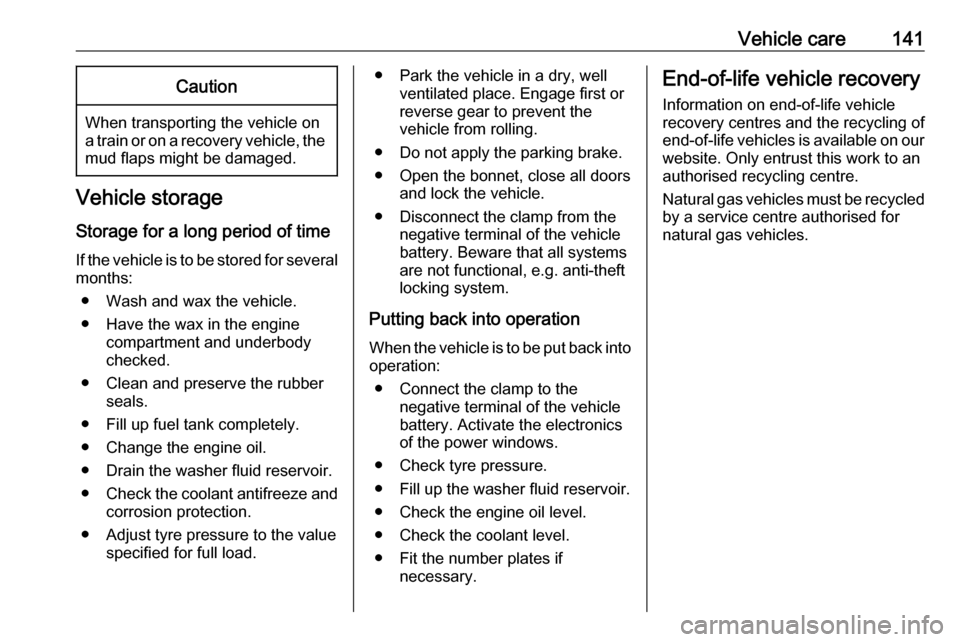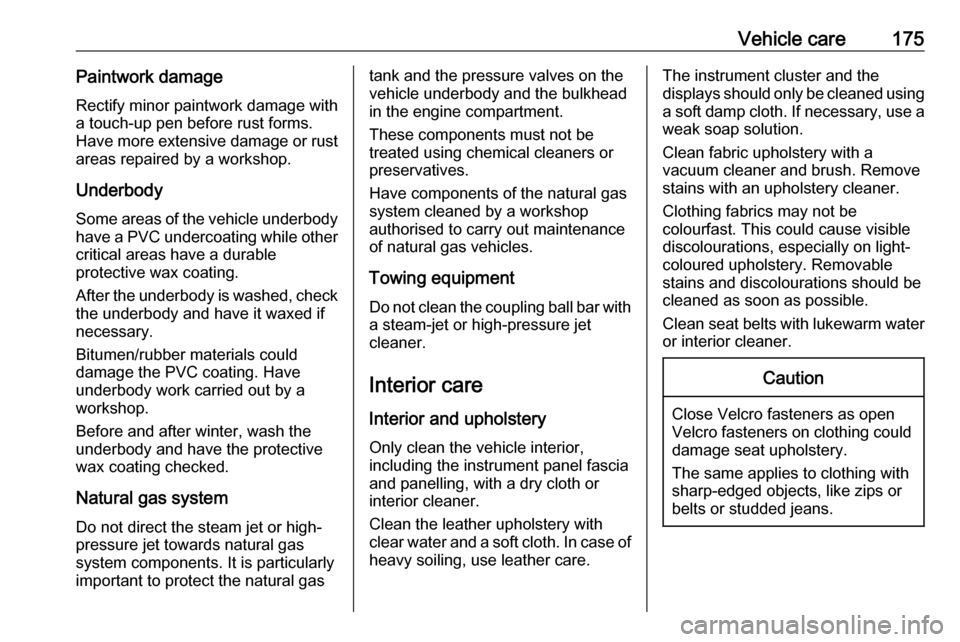open gas tank VAUXHALL COMBO D 2018 Owner's Manual
[x] Cancel search | Manufacturer: VAUXHALL, Model Year: 2018, Model line: COMBO D, Model: VAUXHALL COMBO D 2018Pages: 203, PDF Size: 4.76 MB
Page 138 of 203

136Driving and operating
The fuel filler cap can be retained in
the bracket on the fuel filler flap.
To refuel, fully insert the pump nozzle
and switch it on.
After automatic cut-off, the tank can be topped up by operating the pump
nozzle a maximum of two more times.
Caution
Wipe off any overflowing fuel
immediately.
To close, replace fuel filler cap and
turn clockwise.
Insert ignition key into fuel filler cap
and turn clockwise to lock, then
remove key.
Close the fuel filler flap.
Natural gas refuelling
Open the fuel filler flap.
9 Warning
Refuel only with a maximum
output pressure of 250 bar. Use
only temperature compensated
filling stations.
The refuelling procedure must be
completed, i.e. the filler neck must be vented.
The capacity of the natural gas tank
depends on outside temperature,
filling pressure and type of refuelling
system.
Close the fuel filler flap after
refuelling.
Terms for " natural gas vehicles "
abroad:GermanErdgasfahrzeugeEnglishNGVs = Natural Gas Vehi‐
clesFrenchVéhicules au gaz naturel –
or – Véhicules GNVItalianMetano auto
Terms for " natural gas " abroad:
Page 143 of 203

Vehicle care141Caution
When transporting the vehicle on
a train or on a recovery vehicle, the
mud flaps might be damaged.
Vehicle storage
Storage for a long period of time
If the vehicle is to be stored for several months:
● Wash and wax the vehicle.
● Have the wax in the engine compartment and underbody
checked.
● Clean and preserve the rubber seals.
● Fill up fuel tank completely.
● Change the engine oil.
● Drain the washer fluid reservoir.
● Check the coolant antifreeze and
corrosion protection.
● Adjust tyre pressure to the value specified for full load.
● Park the vehicle in a dry, wellventilated place. Engage first or
reverse gear to prevent the
vehicle from rolling.
● Do not apply the parking brake.
● Open the bonnet, close all doors and lock the vehicle.
● Disconnect the clamp from the negative terminal of the vehicle
battery. Beware that all systems
are not functional, e.g. anti-theft
locking system.
Putting back into operation
When the vehicle is to be put back into operation:
● Connect the clamp to the negative terminal of the vehicle
battery. Activate the electronics
of the power windows.
● Check tyre pressure.
● Fill up the washer fluid reservoir.
● Check the engine oil level.
● Check the coolant level.
● Fit the number plates if necessary.End-of-life vehicle recovery
Information on end-of-life vehicle
recovery centres and the recycling of
end-of-life vehicles is available on our website. Only entrust this work to an
authorised recycling centre.
Natural gas vehicles must be recycled by a service centre authorised for
natural gas vehicles.
Page 177 of 203

Vehicle care175Paintwork damageRectify minor paintwork damage witha touch-up pen before rust forms.
Have more extensive damage or rust areas repaired by a workshop.
Underbody
Some areas of the vehicle underbody
have a PVC undercoating while other critical areas have a durable
protective wax coating.
After the underbody is washed, check
the underbody and have it waxed if
necessary.
Bitumen/rubber materials could
damage the PVC coating. Have
underbody work carried out by a
workshop.
Before and after winter, wash the
underbody and have the protective
wax coating checked.
Natural gas system
Do not direct the steam jet or high-
pressure jet towards natural gas
system components. It is particularly
important to protect the natural gastank and the pressure valves on the
vehicle underbody and the bulkhead in the engine compartment.
These components must not be
treated using chemical cleaners or
preservatives.
Have components of the natural gas
system cleaned by a workshop
authorised to carry out maintenance
of natural gas vehicles.
Towing equipment
Do not clean the coupling ball bar with a steam-jet or high-pressure jet
cleaner.
Interior care
Interior and upholstery
Only clean the vehicle interior,
including the instrument panel fascia
and panelling, with a dry cloth or
interior cleaner.
Clean the leather upholstery with
clear water and a soft cloth. In case of heavy soiling, use leather care.The instrument cluster and the
displays should only be cleaned using
a soft damp cloth. If necessary, use a
weak soap solution.
Clean fabric upholstery with a
vacuum cleaner and brush. Remove
stains with an upholstery cleaner.
Clothing fabrics may not be
colourfast. This could cause visible
discolourations, especially on light-
coloured upholstery. Removable
stains and discolourations should be
cleaned as soon as possible.
Clean seat belts with lukewarm water or interior cleaner.Caution
Close Velcro fasteners as open
Velcro fasteners on clothing could damage seat upholstery.
The same applies to clothing with
sharp-edged objects, like zips or
belts or studded jeans.
Page 199 of 203

197Chimes......................................... 95
Cigarette lighter ........................... 75
Climate control ............................. 15
Climate control systems .............106
Clock....................................... 72, 90
CNG.............................. 77, 135, 190
Collision damage repair ..............193
Control indicators.......................... 79
Control of the vehicle .................113
Controls ........................................ 70
Convex shape .............................. 29
Coolant and antifreeze ...............178
Cruise control ...................... 90, 130
Cupholders .................................. 61
D
Danger, Warnings and Cautions ...4
Date .............................................. 90
Daytime running lights ..........90, 100
Declaration of conformity ............192
Diesel particle filter ...............86, 120
Distance to next service ...............90
Door open .................................... 90
Doors ...................................... 25, 27
Drain fuel filter ............................. 89
Driver assistance systems ..........130
Driver Information Centre .............90
Driving characteristics and towing tips .............................. 138
Driving hints ................................ 113E
Eco mode (E).............................. 124
Electric adjustment ......................29
Electrical system......................... 155
Electronic climate control system 108
Electronic driving programmes ..124
Electronic Stability Control ..85, 129
Electronic Stability Control (ESC). 85
End-of-life vehicle recovery .......141
Engine compartment fuse box ...156
Engine coolant ........................... 144
Engine coolant temperature ........86
Engine coolant temperature gauge ....................................... 78
Engine data ............................... 183
Engine exhaust .......................... 120
Engine identification ...................181
Engine oil ...........143, 178, 182, 190
Engine oil pressure ......................87
ESC (Electronic Stability Control) 129
Event data recorders ..................194
Exit lighting ................................ 105
Extendable load compartment cover ................................... 63, 67
Exterior care .............................. 173
Exterior light ................................. 89
Exterior lighting ......................12, 99
Exterior mirrors ............................. 29F
Fault ........................................... 125
Fixed air vents ........................... 111
Fog light ....................................... 90
Fog lights ................................... 151
Folding front passenger seat ........37
Folding mirrors ............................. 30
Folding seats .......................... 40, 41
Front airbag system .....................51
Front fog lights ........................... 101
Front passenger seat Folding ...................................... 37
Table position ............................ 37
Front seats.................................... 35
Front storage ................................ 61
Front turn signal light ..................149
Fuel............................................. 134
Fuel consumption .........................90
Fuel consumption - CO 2-
Emissions ............................... 137
Fuel cut-off system .........81, 96, 115
Fuel for diesel engines ..............134
Fuel for natural gas operation ...135
Fuel for petrol engines ...............134
Fuel gauge ................................... 77
Fuel selector ................................ 77
Fuel system messages .........96, 115
Fuel tank ..................................... 190
Fuses ......................................... 155